I started it oh, more than a year and a half ago. Here is what it looks like today:
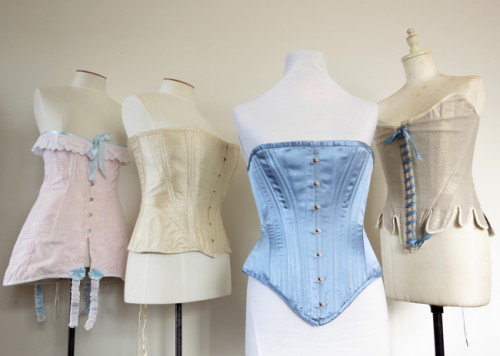
(hint: it’s the blue one)
Yeah. It’s still not quite done.
The problem is that I got it perfectly finished to the point of wearability, didn’t have an event to wear it to, and thus haven’t been really motivated to finish it.
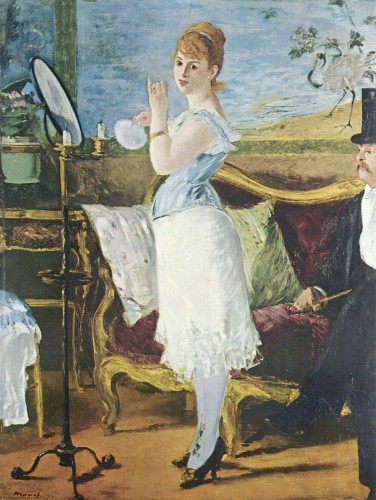
Nana, Edouard Manet, 1877
It is (obviously) inspired by Manet’s Nana, which rather amuses me, because I’m pretty much as far as you could get from Zola’s Nana as a person!
So what does it need to be finished? Sleeves straps. That’s it.

I’m hoping the ‘Wood, Metal, Bone’ challenge will motivate me to finish it, though in retrospect I should really have finished it for Literature!
Still, even not-quite-done, I think it looks rather spiffy on me.
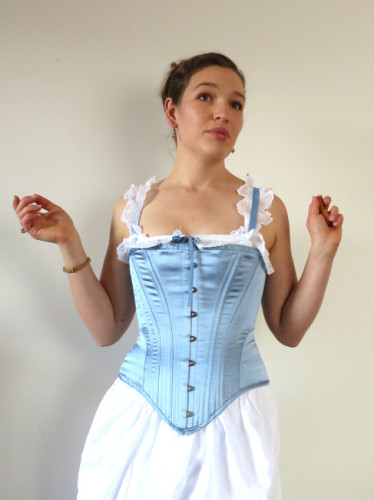
It’s so, so, so comfortable! 1870s corsets with gussets really are amazing.

Compare it to the original:
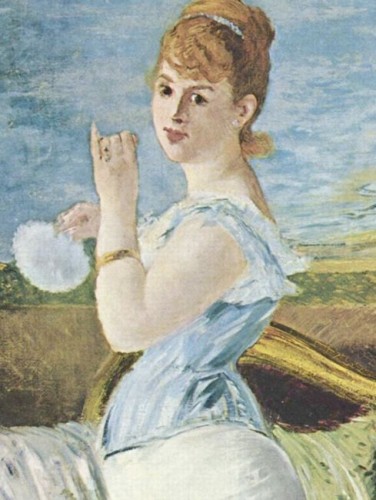
Manet’s Nana, 1877 (detail)
And my favourite of this series of boring-white-wall timer shots:
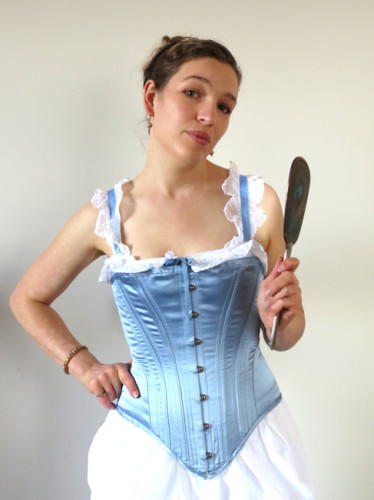

It’s quite pretty! I love the shade of blue, it’s just so dreamy! I think when it’s done you should try to do an re-enactment picture of the painting with Mister D dressed up as the gentleman 😉
On another note, I just wondered when I saw the last picture, what causes the wrinkles in certain panels of the corset? I have once been told (by a so called friend but I now doubt a lot of things she taught me) that it is when the supporting fabric is not sturdy enough, is that true?
Thanks Hasel!
Some wrinkles in corsets are inevitable just from the pressure that’s put on them (look at Manet’s painting, and you can see the wrinkles at Nana’s waist), but mine is wrinkling a trifle more than it ought too because I cut some panels very slightly off-grain due to lack of fabric. I think grainline problems or poor fit are the cause of 90% of the corset wrinkles I’ve seen.
Ah okay thanks, that makes a lot of sense! 😀
What an absolutely cute little thing with those frills!
Thanks Tav! The frilly thing is my chemise – it was actually one of the first 1870s chemises that I made, and is not very accurate and a bit worn now, but I still rather like it.
Very nice, and very nearly identical to the original inspiration painting! Good work.
Thanks Catherine! I’m really pleased with how much it looks like the inspiration.
I love that shade of blue, too. I did not think those were straps from the corset, though I guess it makes sense with the same colour… and yes, it is absolutely cute with them!
It’s such a delightful shade isn’t it? I’ve studied and studied the painting to figure out it if is a corset with straps, or her chemise with ribbon, and I do think it is a corset. There are so many examples of 1870s corsets with shoulder straps, and so few examples of 1870s chemises with any colour that a strapped corset just makes sense. In the pictures I’m wearing it with a chemise with pale blue shoulder straps, but that’s not the finished look I’m aiming for.
Ah, your new corset is stunning! You look fabulous! 🙂
Ah, and all your corsets are wonderful! 🙂
Is there a pattern you usually use as a start for your 1870’s corsets? Or is it drafted from a specific book? I’m using Truly Victorian for the wood, metal, bone challenge, but love to hear what other people use.
How do you fit a corset? Do you put boning in your muslin? I have a friend who says that she just puts on a different corset and fits the muslin over that, but that doesn’t make sense, because what if the other corset doesn’t fit right? I want to make a (well-fitting!) corset as part of a costume, and I even have a pattern, but I know nothing about how to fit them.
There are lots of different ways to fit a corset. I fit mine by really knowing my body, and pattern drafting, but that takes a lot of experience. Probably the easiest way is to make a toile in really heavy fabric, and make a set of fitting grommets which you can sew on to the back of any mock up, so that you can lace it in to fit it.